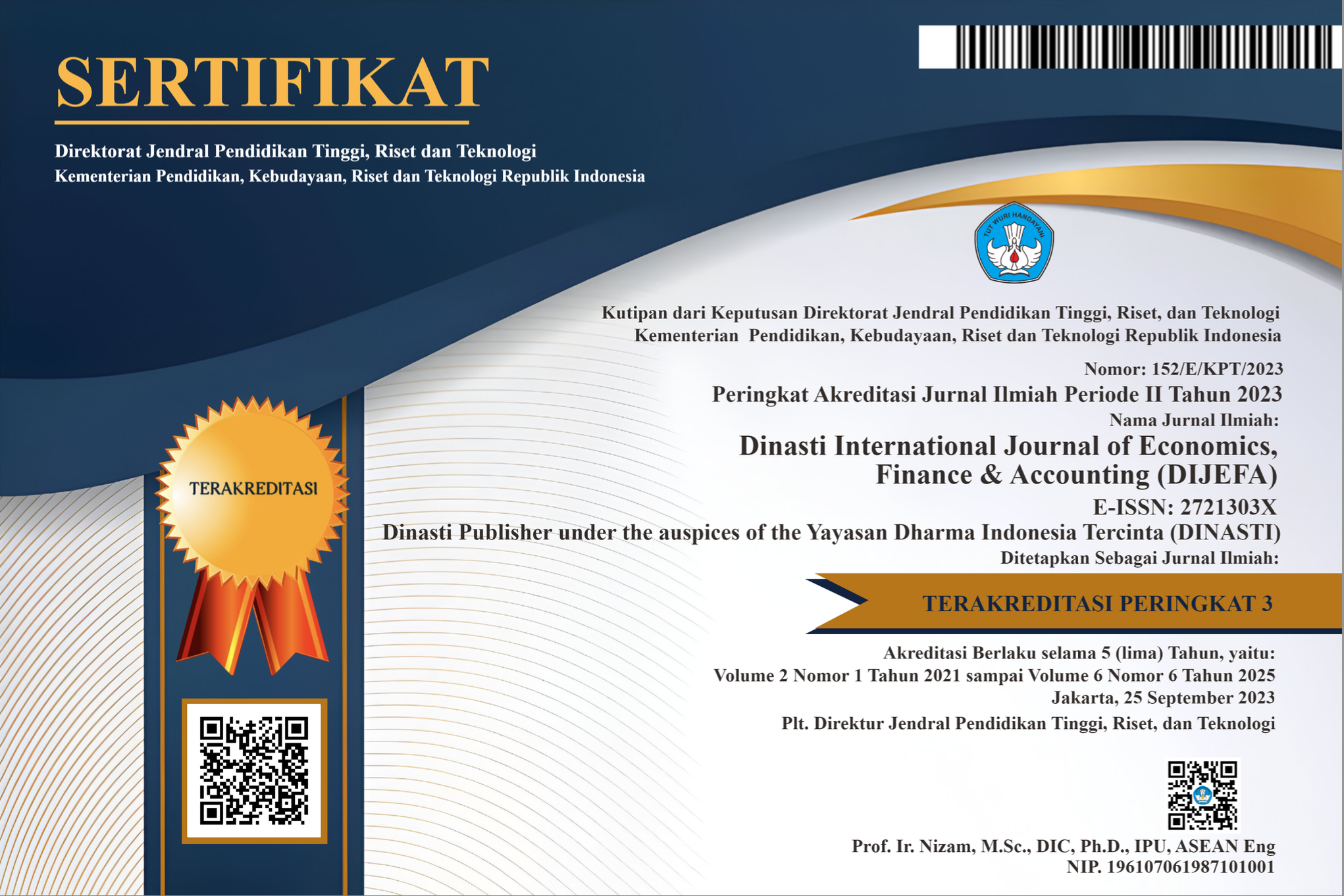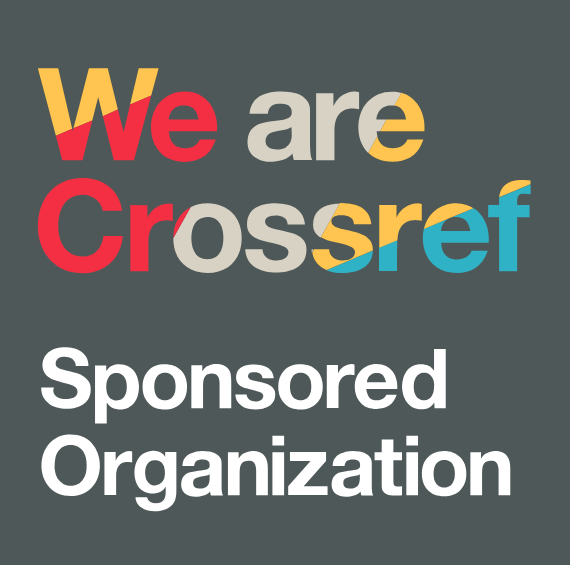Analysis of Theory of Planned Behavior and Fraud Triangle Theory (Case Study On Sharia Banking)
DOI:
https://doi.org/10.38035/dijefa.v5i2.2723Keywords:
Theory Of Planned Behavior, Fraud Triangle Theory, Attitude, Subjective Norms, Behavioral Control, Pressure, OpportunityAbstract
The aim of this research is to test whether attitudes, subjective norms, behavioral control, pressure and opportunities influence the interest of staff in Sharia Banking to commit fraud. The survey was conducted on a sample of 35 sharia banking staff. The research results show that attitudes and pressure influence the interest of Sharia Banking staff to commit acts of fraud, while Subjective Norms, Behavioral Control, and Opportunity do not influence the interest of Sharia Banking staff to commit acts of fraud.
References
Abdillah, W., & Hartono, H. (2015). Partial least square (pls) alternatif structural equation modeling (sem) dalam penelitian bisnis. Yogyakarta: Andi.
ACFE (Association of Certified Fraud Examiners). (2019). SURVEI FRAUD INDONESIA.
ACFE. (2022). Occupational Fraud 2022: A Report to the nations. Acfe, 1–96.
Ajzen, Icek. 1991. The Theory of Planned Behavior. Organizational Behavior and Human Decision Process. Vol. 50: 179-211.
Akbar et al (2017). “Relevansi Fraud Triangle pada Bank Syariah”, Syariah Paper Accounting SNA XX, Jember, 2017, UIN Raden Patah Palembang.
Albrecht, W. Steve., Chad O. Albrecht., Conan C. Albrecht., dan Mark F. Zimbelman. 2012. Fraud Examination. Mason: Cengage Learning.
Al-Gahtani, S. S. (2010). Modeling The Electronic Transactions Acceptance Using An Extended Technology Acceptance Model. Applied Computing and Informatics, 9, 47-77.
Alimbudiono, Lia Sandra.(2020). Konsep Pengetahuan Akuntansi Manajemen Lingkungan, Surabaya : CV. Jakad Media Publishing.
Amrullah, M. M., & Novianti Nurlita. (2016). Implementasi Theory of Planned Behavior dalam Mendeteksi Minat dan Perilaku Fraud pada Sektor Publik (Studi pada Bagian Keuangan di SKPD se-Kota Probolinggo).
Awang, Y., Ismail, S., dan Rahman, A. R. A., (2015), Measuring The Potential for Financial Reporting Fraud in a Highly Regulated Industry. Asia Pacific Conference on Accounting and Finance in Bali – Indonesia.
Bank Syariah Indonesia. (2023). Ekspansi dan Akselerasi Bisnis untuk Pertumbuhan Berkelanjutan. Jakarta: PT Bank Syariah Indonesia Tbk.
Baqir, N. A., & Sulhani, S. (2023). Corporate Governance, Effectiveness of Internal Audit Function and Fraud in Islamic Banking in Indonesia. Asia Pacific Fraud Journal, 8(1), 77–84.
Becker, D’Arcy., Janice Connoly., Paula Lentz., Joline Morrison. 2006. Using The Business Fraud Triangle to Predict Academic Dishonesty Among Business Students: ProQuest: 37.
Beck, L., &Ajzen, I. 1991.Predicting dishonest actions using the theory of planned behavior. Journal of Research in Personality, 25, 285-301.
Biduri, S. (2018). Apakah Theory Planned of Behaviour Dapat Mempengaruhi Perilaku Academic Fraud?. Journal of Accounting Science, 2(2), 151-164. https://doi.org/10.21070/jas.v2i2.2097
Carpenter, Tina D., and Jane L. Reimers. 2005. Unethical and Fraudulent Financial Reporting: Applying the Theory of Planned Behavior: Journal of Business Ethics. Vol. 60: 115-129.
Christina, L., & Kristanto, S. B. (2019). Mendeteksi Perilaku Fraud Laporan Keuangan Dengan Theory Of Planned Behavior (Studi Empiris Pada Industri Perbankan). In JAKO)-VOL (Vol. 11).
Cressey, Donald R. 1953. Other People’s Money. Montclair, NJ: Patterson Smith.
Fishbein, M., dan Icek Ajzen. 1975. Belief, Attitude, Intention, and Behavior: An Introduction to Theory and Research (Addison-Wesley, Reading, MA).
Fitriana, Annisa., dan Zaki Baridwan. 2012. Perilaku Kecurangan Akademik Mahasiswa Akuntansi: Dimensi Fraud Triangle. Jurnal Akuntansi Multiparadigma (JAMAL). Vol. 3: 161-331.
Hess, D. 2007. A Business Ethics Perspective on Sarbanes-Oxley and The Organizational Sentencing Guidelines. Michigan Law Review. Vol. 105: 1781-1816.
Jogiyanto. (2007). Sistem Informasi Keperilakuan. Yogyakarta: Andi.
Laela, S. F., & Akun, R. S. (2022). Etika Islami Dan Kecurangan Pada Profesi Akuntan Manajemen: Dampak Moderasi Kualitas Pengendalian Internal Dan Lingkungan Kerja. Jurnal Riset Manajemen Sekolah Tinggi Ilmu Ekonomi Widya Wiwaha Program Magister Manajemen, 9(2), 74–92. https://doi.org/10.32477/jrm.v9i2.463
Meliana, & Trie Rundi Hartono. (2019). Fraud Perbankan Indonesia: Studi Eksplorasi.
Munirah, A., & Nurkhin, A. (2018). Pengaruh Faktor-Faktor Fraud Diamond Dan Gone Theory Terhadap Kecurangan Akademik. Economic Education Analysis Journal, 7(1), 120-139.
Nugraheni, N. K., & Triatmoko, H. (2017). Analisis Faktor-Faktor Yang Mempengaruhi Terjadinya Financial Statement Fraud: Perspektif Diamond Fraud Theory. Jurnal Akuntansi Dan Auditing, 14(2), 118–143.
Rezaee, Z. (2002). Financial statement Fraud: prevention and detection. John Wiley & Sons.
Sekaran, U. & Bougie, R.J., (2016). Research Methods for Business: A skill Building Approach. 7th Edition, John Wiley & Sons Inc. New York, US.
Sholihin, M. Ratmono, D. 2013. Analisis SEMPLS dengan WarpPLS 3.0 untukHubungan Nonlinier dalam Penelitian Sosial dan Bisnis. Yogyakarta: Penerbit Andi.
Tuanakotta, Theodorus M. 2013. Akuntansi Forensik dan Audit Investigatif. Jakarta: Salemba Empat.
Wahyuni, W., & Budiwitjaksono, G. S. (2017). Fraud Triangle Sebagai Pendeteksi Kecurangan Laporan Keuangan. Jurnal Akuntansi, 21(1), 47. https://doi.org/10.24912/ja.v21i1.133
Widyarani, Nilan.(2009). Psikologi Populer: Kunci Pengembangan Diri, Jakarta : PT Elex Media Konputindo.
Yelpi, Rahmawati, S. E. ,M. Si. ,AK. ,CA. ,CSRS. ,CSRA, & Saharuddin, S. E. ,M. M. (2022). Analisis Pengaruh Fraud Triangle Terhadap Perilaku Kecurangan Akademik Pada Mahasiswa Akuntansi (Studi Pada Mahasiswa Akuntansi Universitas Muhammadiyah Palopo).
Downloads
Published
How to Cite
Issue
Section
License
Copyright (c) 2024 Nadin Nadin, Rahma Wijayanti

This work is licensed under a Creative Commons Attribution 4.0 International License.
Authors who publish their manuscripts in this journal agree to the following conditions:
- The copyright on each article belongs to the author(s).
- The author acknowledges that the Dinasti International Journal of Economics, Finance & Accounting (DIJEFA) has the right to be the first to publish with a Creative Commons Attribution 4.0 International license (Attribution 4.0 International (CC BY 4.0).
- Authors can submit articles separately, arrange for the non-exclusive distribution of manuscripts that have been published in this journal into other versions (e.g., sent to the author's institutional repository, publication into books, etc.), by acknowledging that the manuscript has been published for the first time in the Dinasti International Journal of Economics, Finance & Accounting (DIJEFA).


























































